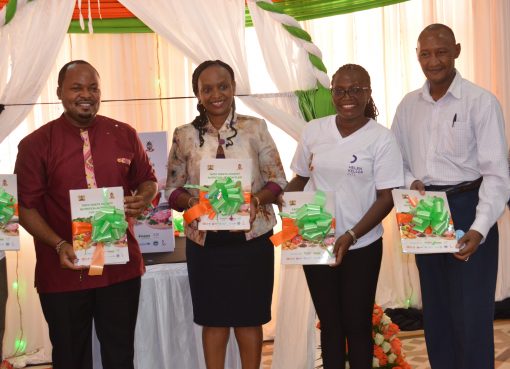For hours, she stood still under the blazing Tsavo sun. Her eyes were narrowed to a squint to manage the sharp glare of the midday sun. Her slight frame under the green uniform and heavy military black boots never once betray any sign of fatigue.
When the final order rang out to dismiss the parade, she proudly marched past the raised dais, head held high, eyes rigidly fixed right, a winner.
“It was tough. We came with no idea what to expect. We now leave here a different people; resilient, wiser and tough. We are going to be the agents of positive change in our communities,” says Rahma Hassan, a community ranger from Kinna Community Conservancy in Isiolo County.
At 27, Ms. Hassan is the symbol of changing face of wildlife conservation amongst members of pastoralist community in the arid Northern Kenya.
On Friday, she was amongst 26 women from a group of 233 community rangers drawn from 43 conservancies under the Northern Rangeland Trust (NRT) who graduated from Kenya Wildlife Service (KWS) Law Enforcement Academy at Manyani in Voi Sub-County.
For three months, the rangers underwent intensive training on wildlife conservation, community enterprise, and management of human-wildlife conflict, bush craft and first-aid skills.
Years back, it was unheard of for a young woman to don ranger’s boots and green fatigue and devote her life to the protection of wild animals. This was particularly the perception towards women from Somali and other Cushitic communities where conservation was regarded as a preserve for men.
Currently, conservancies are attracting dozens of women community rangers who are shattering the misogynistic myths by making an indelible impact in wildlife conservation.
Out of the 4,201 community rangers across over 160 conservancies in Kenya, women rangers are at 207. This number is expected to soar as gender-mainstreaming takes root in community conservancies.
Ms. Hassan says outdated views of conservation as being only about men and wildlife have metamorphosed to include a practical approach that entails community involvement and improvement of livelihoods at a domestic level.
“The betterment of communities in wildlife zones and improvement of livelihoods is key to what we do. This is the new frontier of conservation activities,” she says.
Former KWS Director, Dr. Julius Kipng’etich, says the future of wildlife conservation in the country is pegged on full involvement of communities by the government through collaboration and strategic partnerships.
He explains that communities are gradually embracing wildlife because of the rewarding outcomes and benefits that emanate from their active involvement in conservation activities.
Dr. Kipng’etich, who is the current Board Chair of NRT, says one of the major challenges facing wildlife is shrinking land for wildlife to thrive in.
Noting that the government does not have idle land to create additional protected areas for wildlife to thrive in, he says the only land available is owned by communities and individuals which reinforces the urgent need to make them key partners in conservation.
Conservancies and ranches in Kenya occupy a land mass larger than the combined total of all national parks. NRT alone with its 44 conservancies occupy an area of over 44,000 square kilometers. Taita-Taveta Wildlife Conservancies Association with over 30 conservancies has over 1.1 million acres.
“The need for collaboration between government and communities has never been greater. It will open up new areas for wildlife while allowing communities to participate and benefit from conservation activities,” he explains.
He proposes a review of the current Wildlife and Management Act of 2013 to acknowledge and strengthen the role communities play in enhancing wildlife conservation. He notes that the law, in its current form, places a lot of burden and responsibility on the government while communities’ role in protecting biodiversity remains marginal.
“A review is needed to highlight the crucial role communities play in conservation. This would allow the government to pump investments and other resources in conservancies hosting diverse wildlife to bolster conservation activities,” he said.
Conservancies, especially in Northern Kenya, are faced with a myriad of unique challenges. They include climate change, biodiversity loss, pollution and proliferation of illegal arms. A key aspect of combating such emerging challenges include working with government in training of community rangers on modern aspects of conservation. This, he says, will provide employment opportunities for the youth while supporting the government’s role in protection of wildlife.
Dr. Kipn’getich says rangers will also act as the link between the communities and conservancies to address issues like human wildlife conflict, enterprises and job creation.
“We are collaborating with KWS to have the community rangers become the new face of conservation in the North. They have discipline and skills and those are the traits needed in conservation,” he said.
He added that NRT would approach KWS for assistance in introducing wild animals in conservancies that have abilities and capacities to host such species. He cited the success of the rhino breeding program at Sera Conservancy as proof of communities’ ability to care even for the endangered species.
“We will soon engage KWS on putting wild animals in the conservancies. We are confident they will thrive as demonstrated by the success at Sera community conservancy,” he said.
Mr. Samuel Lekimaroro, Head of Security in NRT says the 233 rangers who graduated from the KWS Law Academy is the highest number to have ever graduated at a time. He adds that NRT, cutting across 10 counties, has 1050 rangers. Half of them have been trained at the LEA with an additional 150 expected to report for training in September.
“We expect our rangers to address issues with livelihood improvement and conflict management in the communities. We are committed to ensuring women from the communities are also part of this progressive program,” he said.
Ms. Nancy Kabete, KWS Deputy Director-In-Charge of Operations, notes that KWS’s strategic plan is anchored on pillars of conservation, collaboration and enterprise. She adds that collaboration with partners and conservancies has been beneficial through increasing the number of rangers outside the protected area while the training would see them discharge their duties with decorum and professionalism.
Ms. Kabete, who was representing the Director General during the event, said KWS had introduced a post-training monitoring to assess the trained community rangers as they worked in the field. This would help in identifying the gaps and making necessary improvements to equip rangers with requisite skills.
“We are glad to have more boots outside the protected area. We will be sending officers to monitor what you have learnt from here to see if it is being implemented. This will act as a feedback to help the training identify gaps and improve where necessary,” she said.
Others who were at the event include NRT Chief Executive Officer Mr. Tom Lalampaa, The Nature Conservancy Country’s Program Director Munira Anyonge, Kenya Wildlife Conservancies Association Boss Mr. Dickson Kaelo and NRT founder and KWS Board member Ian Craig.
By Wagema Mwangi





